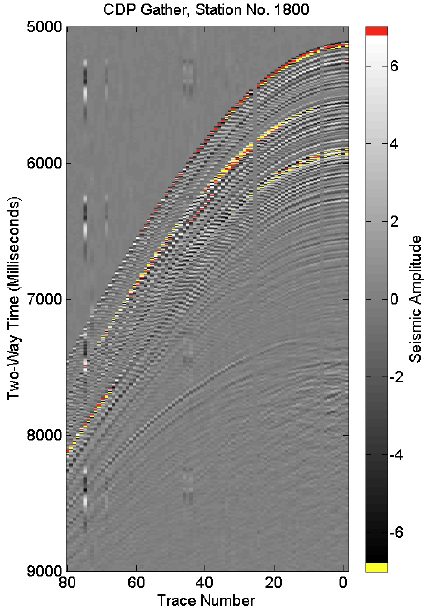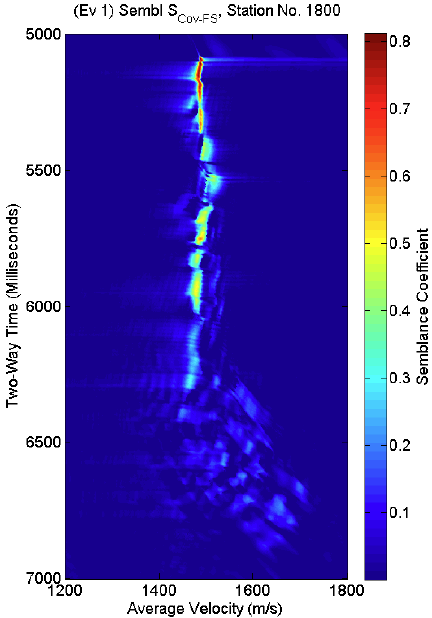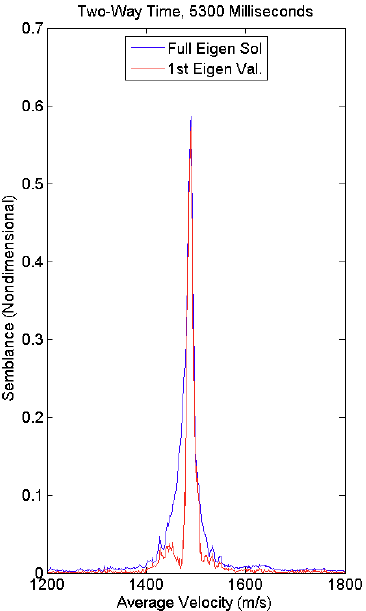BACKGROUND
The ability to accurately estimate seismic velocity is vital to accurate, common depth point (CDP) processing and seismic interpretation for structural interpretation and even more so for stratigraphic interpretation. Calculating the velocity spectra using the conventional semblance coefficient is still the predominant method even though this approach does not have the resolving power of subspace methods. This fast-covariance invention provides a nearly noise-free estimate identical to the standard spatial covariance estimate from subspace methods for the semblance coefficient without the high computational cost.
SUMMARY OF TECHNOLOGY
Conventional semblance for seismic velocity analysis includes the computation of a velocity spectra. Due to the inclusion of the noise-signal space, conventional semblance does not have the resolving power of subspace methods. After nearly three decades of development, subspace techniques still receive little use in seismic applications due to high computational costs. We develop an approach to compute the seismic velocity spectra based on subspace methods without the high computational cost. This approach appropriately recognizes covariance analysis as a rank reduction process. Whether an outer or inner product is used, the full information content is preserved in identical sets of reduced-rank Eigenvalues.
A solution with the resolution of the spatial data covariance matrix is obtained with a much lower computational cost. As a consequence, this fast-spatial covariance solution is significantly more competitive to conventional semblance in computational cost.
POTENTIAL AREAS OF APPLICATION
- This algorithm is an alternative algorithm to replace the conventional semblance coefficient velocity spectra calculations ahead of the NMO and stacking processes in 2D and 3D seismic CDP processing when higher resolution velocity estimations are warranted.
- This development may have application in other areas where rank reduction has not been properly exploited to reduce computational costs.
MAIN ADVANTAGES
- Higher resolution results for seismic velocity spectra than conventional semblance coefficient.
- Lower computational cost than traditional spatial covariance semblance.
- More closely competitive in computational cost with the approach using conventional semblance.
STATE OF DEVELOPMENT
Oklahoma State University has filed a patent application to protect a composition of algorithms and methods for the proposed technology.


Figure 1. (Left) Common Depth Point (CDP) Gather. This displays the normal moveout (NMO) for the CDP gather at Station No. 1800 on line 9A (?). Several important markers are shown. This includes the positive ocean bottom reflector, a bottom simulating reflector (BSR) representing the bottom of the hydrate stability zone, and a positive BSR representing the CT transition.
Figure 2. (Right) Semblance Velocity Spectra. This display shows the Eigen spectra from the Fast-Spatial Covariance semblance calculation, which is identical to both conventional semblance and the Spatial Covariance semblance. The difference with the first Eigen solution will be seen in Figure 3.

Figure 3. Comparison of Semblance Velocity Spectra. In this Figure, we compare profiles of the first Eigen solution and the full Eigen solution semblance spectra for Fast-Spatial Covariance semblance using line profiles across the velocity dimension of Figure 2 to quantify the improvement using Eigen decomposition.